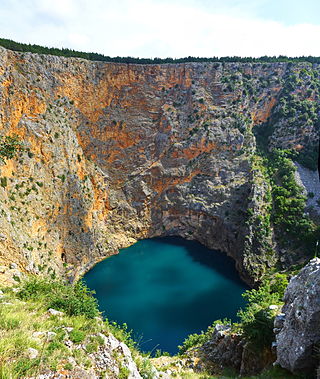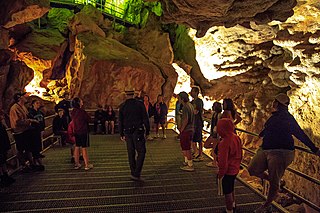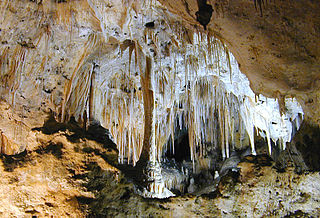
A sinkhole is a depression or hole in the ground caused by some form of collapse of the surface layer. The term is sometimes used to refer to doline, enclosed depressions that are also known as shakeholes, and to openings where surface water enters into underground passages known as ponor, swallow hole or swallet. A cenote is a type of sinkhole that exposes groundwater underneath. Sink, and stream sink are more general terms for sites that drain surface water, possibly by infiltration into sediment or crumbled rock.

The Natural Bridge Caverns are the largest commercial caverns in the US state of Texas. The name is derived from the 60-foot (18 m) natural limestone slab bridge that spans the amphitheater setting of the cavern's entrance. The span was left suspended when a sinkhole collapsed below it.

Blanchard Springs Caverns is a cave system located in the Ozark–St. Francis National Forest in Stone County in northern Arkansas, USA, 2 miles (3.2 km) off Highway 14 a short distance north of Mountain View. It is the only tourist cave owned by the United States Forest Service and the only one owned by the federal government outside the National Park System. Blanchard Springs Caverns is a three-level cave system, all of which can be viewed on guided tours.
Krubera Cave is the second-deepest-known cave on Earth, after the Veryovkina Cave. It is located in the Arabika Massif of the Gagra Range of the Western Caucasus, in the Gagra District of Abkhazia, a partly recognised state, previously part of Soviet Georgia.

Jewel Cave National Monument contains Jewel Cave, currently the fifth longest cave in the world and second longest cave in the United States, with 220.01 miles (354.07 km) of mapped passageways as of May 2024. It is located approximately 13 miles (21 km) west of the town of Custer in Black Hills of South Dakota. It became a national monument in 1908.

At 150.4 miles (242.0 km), Lechuguilla Cave is the eighth-longest explored cave in the world and the second deepest in the continental United States. It is most famous for its unusual geology, rare formations, and pristine condition.

Carlsbad Caverns National Park is a national park of the United States in the Guadalupe Mountains of southeastern New Mexico. The primary attraction of the park is the show cave Carlsbad Cavern. Visitors to the cave can hike in on their own via the natural entrance or take an elevator from the visitor center.

Germany Valley is a scenic upland valley high in the Allegheny Mountains of eastern West Virginia originally settled by German farmers in the mid-18th century. It is today a part of the Spruce Knob–Seneca Rocks National Recreation Area of the Monongahela National Forest, although much ownership of the Valley remains in private hands.

Grand Caverns, formerly known as Weyer's Cave, is located in the central Shenandoah Valley in the town of Grottoes, Virginia, United States. A limestone cavern, it claims the distinction of being America's oldest show cave, in operation since 1806.

The Lost River is a river that rises in Vernon Township, Washington County, Indiana, and discharges into the East Fork of the White River in Lost River Township, Martin County, Indiana. The river's unusual hydrology has led to two of its features being named as National Natural Landmarks.

Ricks Spring is a karst spring, a natural water outflow from a cave in Logan Canyon within the Wasatch-Cache National Forest in northeast Utah. The spring is not an artesian source, but comes from the Logan River. Ricks Spring is the best known of several springs in an underground water network of the area.

Škocjan Caves is a cave system located in Slovenia. Škocjan Caves was included on UNESCO’s list of natural and cultural World Heritage Sites in 1986. Škocjan Caves is a significant underground phenomenon on the Karst Plateau and in Slovenia. After gaining independence from Yugoslavia in 1991, Slovenia made a commitment to actively protect the Škocjan Caves area. To fulfill this commitment, Škocjan Caves Regional Park was established, along with its managing authority, the Škocjan Caves Park Public Service Agency.
Onyx Cave is a solutional cave system with about 0.5 miles (0.8 km) of passages formed in Permian limestone in the Santa Rita Mountains of Arizona. It is part of the Coronado National Forest. It was designated a National Natural Landmark in 1974.

Short Drop Cave and Gavel Pot are different entrances into the same cave system on Leck Fell, in Lancashire, England. The main top entrance, Short Drop Cave, is a small hole in a fenced-off shakehole near the main stream sink. Gavel Pot, a window into the system, is a large fenced shakehole some 40-metre (130 ft) deep requiring tackle to descend. There are two other smaller entrances into Short Drop Cave. At its base the system links via a sump with Lost Johns' Cave, and is part of the Three Counties System, an 87 kilometres (54 mi) cave system which spans the borders of Cumbria, Lancashire, and North Yorkshire.

Tears of the Turtle Cave is located in the Bob Marshall Wilderness in western Montana and is currently the deepest known limestone cave in the United States since passing New Mexico's Lechuguilla cave in 2014. As of August 2024, the cave is known to be 2,477 feet (755 m) deep and 1.88 miles (3,030 m) long. The cave consists mostly of narrow fissure passages passing over approximately 50 short rope drops. The cave has a temperature of 37 °F (3 °C), and it is muddy and poorly decorated.

Boybuloq is a limestone cave in Uzbekistan, the deepest cave in Central Asia and all Asia except its western part. The cave is 1,517 metres (4,977 ft) deep and 18,400 metres (60,400 ft) long with the main entrance at an elevation of 2,647 metres (8,684 ft). It is situated at the edge of Baysun-Tau mountain ridge, the southern spur of the Gissar Range, in the southeast of the country. The nearest village is Dehibolo, to the northeast of Boysun.

Ekaterinburg Speleo Club (SGS) (from Sverdlovskaja Gorodskaja Speleosekcija; Свердловская Городская Спелеосекция – СГС), founded in 1961, is a Russian, non-profit speleological organization dedicated to the exploration, research, and conservation of caves. It is based in Ekaterinburg (named Sverdlovsk from 1924 to 1991), the fourth largest city of Russia, in the Middle Urals and on the western edge of Siberia. SGS is most known for the exploration of caves in the northern Sverdlovsk Oblast and high-mountain karst areas of Surxondaryo Region in Uzbekistan, including Boybuloq, the deepest cave in Central Asia and one of the deepest caves in the world.

Cave diving is underwater diving in water-filled caves. The equipment used varies depending on the circumstances, and ranges from breath hold to surface supplied, but almost all cave diving is done using scuba equipment, often in specialised configurations with redundancies such as sidemount or backmounted twinset. Recreational cave diving is generally considered to be a type of technical diving due to the lack of a free surface during large parts of the dive, and often involves planned decompression stops. A distinction is made by recreational diver training agencies between cave diving and cavern diving, where cavern diving is deemed to be diving in those parts of a cave where the exit to open water can be seen by natural light. An arbitrary distance limit to the open water surface may also be specified. Despite the risks, water-filled caves attract scuba divers, cavers, and speleologists due to their often unexplored nature, and present divers with a technical diving challenge.

The Morca Cave is located on the Taşeli plateau of the Taurus Mountains in the south of Turkey. Discovered in 1996, it had reached an explored depth of 1,276 meters and a length of 5,714 meters at the end of 2020. By then, Morca was Turkey's third deepest and eighth longest known cave. It has not been fully explored.

















